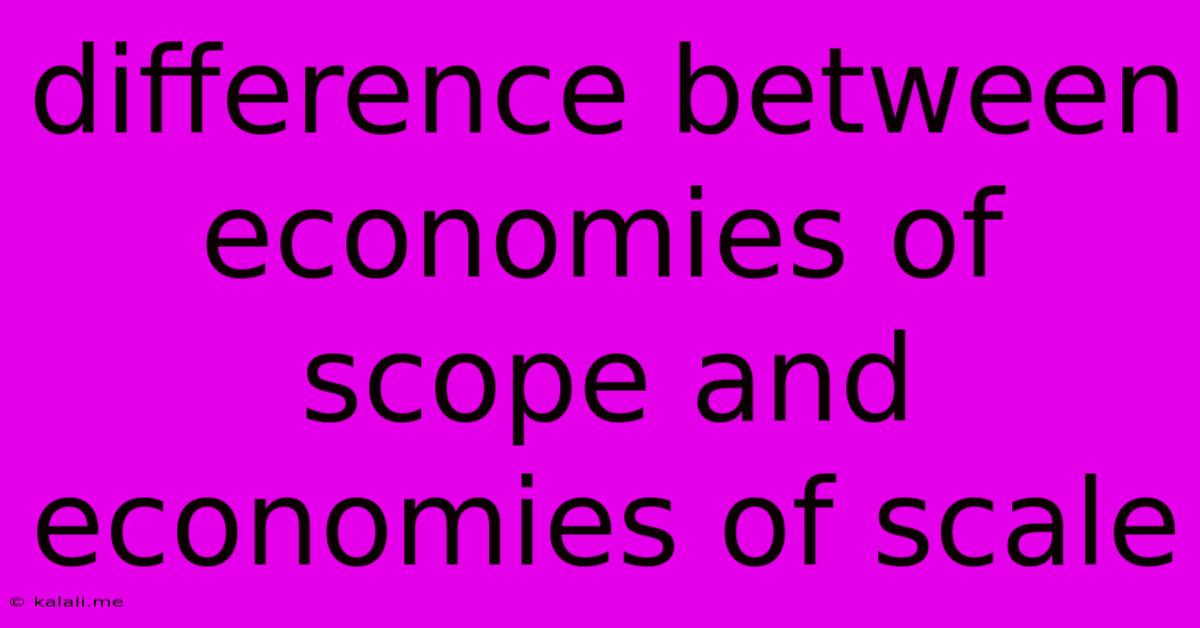Difference Between Economies Of Scope And Economies Of Scale
Kalali
Jun 16, 2025 · 3 min read

Table of Contents
Economies of Scope vs. Economies of Scale: Understanding the Differences
Understanding the difference between economies of scope and economies of scale is crucial for any business aiming for efficiency and profitability. While both concepts relate to cost advantages, they operate in distinct ways and offer different pathways to achieving competitive edge. This article will delve into the nuances of each, highlighting their key differences and providing practical examples. This will help you understand which strategy might be best suited for your business model.
Meta Description: This article clarifies the key differences between economies of scope and economies of scale, explaining how each contributes to cost efficiency and providing practical examples to illustrate their distinct advantages.
What are Economies of Scale?
Economies of scale refer to the cost advantages that businesses achieve by increasing their production volume. The larger the scale of production, the lower the average cost per unit. This is because fixed costs are spread over a larger number of units, leading to a decrease in per-unit cost. Think of it like this: the cost of setting up a factory remains largely the same whether you produce 100 units or 10,000 units. But the cost per unit of production will be significantly lower when producing 10,000 units.
Key Characteristics of Economies of Scale:
- Increased Production Volume: The core driver is producing and selling more units.
- Lower Average Cost Per Unit: The primary benefit is a reduction in the cost of each individual item.
- Focus on Efficiency: Strategies often involve optimizing production processes and utilizing specialized equipment.
- Examples: Mass production of cars, large-scale farming, and bulk purchasing of raw materials.
What are Economies of Scope?
Economies of scope, on the other hand, refer to the cost advantages achieved by producing a wider range of products or services. This is different from economies of scale, where the focus is on increasing the volume of a single product. Economies of scope arise from sharing resources, such as production facilities, distribution networks, or marketing departments, across multiple product lines.
Key Characteristics of Economies of Scope:
- Diversified Product/Service Portfolio: The key is offering a variety of related goods or services.
- Shared Resources and Capabilities: Cost savings stem from utilizing existing infrastructure and expertise across multiple products.
- Synergies and Cross-Selling Opportunities: Economies of scope often lead to increased market reach and cross-selling potential.
- Examples: A company producing both cars and trucks (sharing manufacturing plants and distribution channels), a media company offering television, radio, and online content (leveraging shared marketing and talent), or a bank offering a range of financial products (utilizing a common branch network).
Key Differences Summarized:
| Feature | Economies of Scale | Economies of Scope |
|---|---|---|
| Focus | Increasing production volume of a single product | Producing a wider range of products or services |
| Cost Advantage | Lower average cost per unit | Lower overall cost by sharing resources |
| Primary Driver | Increased production efficiency | Resource sharing and diversification |
| Metric | Cost per unit | Cost across multiple product lines |
Combining Economies of Scale and Scope:
Many successful businesses leverage both economies of scale and scope simultaneously. For example, a large consumer electronics company might achieve economies of scale by mass-producing a particular smartphone model, while simultaneously achieving economies of scope by utilizing the same manufacturing facilities and distribution network to produce tablets and laptops. This integrated approach allows for significant cost advantages and market diversification.
Conclusion:
Understanding the difference between economies of scale and economies of scope is vital for strategic business planning. By carefully analyzing their respective strengths and limitations, businesses can develop efficient production strategies and gain a competitive advantage in the marketplace. Choosing the right approach, or ideally, a combination of both, is key to long-term success and profitability.
Latest Posts
Latest Posts
-
How To Create Clickable Image In Html
Jun 16, 2025
-
What Are The Factors Of 121
Jun 16, 2025
-
What Is A Theme Of The Passage
Jun 16, 2025
-
A Company That Provides Access To The Internet
Jun 16, 2025
-
Which Word Is Closest In Meaning To The Underlined Word
Jun 16, 2025
Related Post
Thank you for visiting our website which covers about Difference Between Economies Of Scope And Economies Of Scale . We hope the information provided has been useful to you. Feel free to contact us if you have any questions or need further assistance. See you next time and don't miss to bookmark.